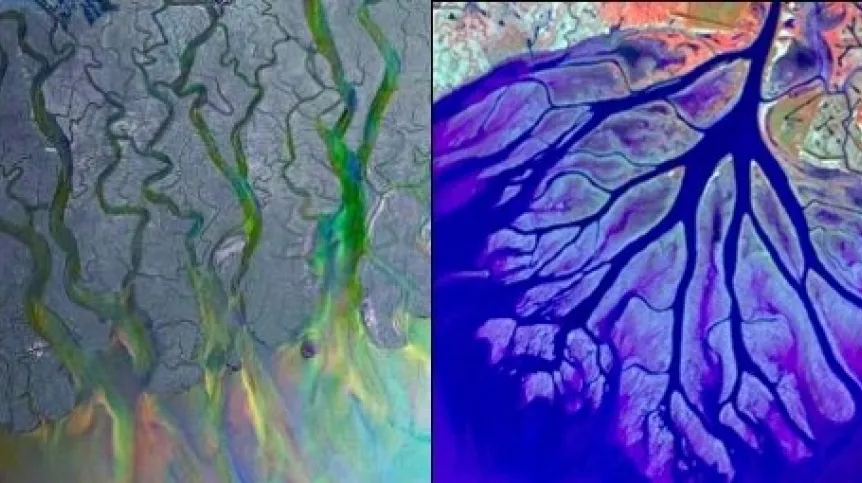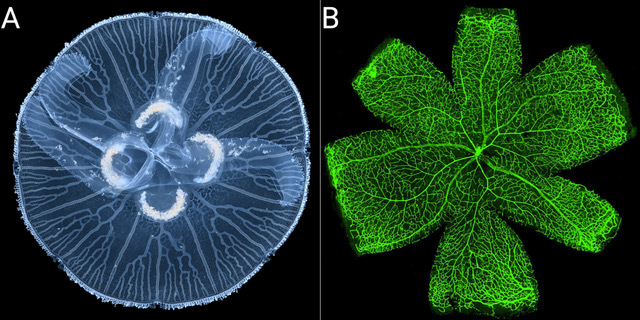
In blood vessels, leaf veins and river systems, physicists see so-called transport networks. What conditions favour the formation of loops that make the entire system resistant to damage has now been investigated by a team of scientists from Poland and America.
'Tree-like structures are effective for transport, but networks that contain loops are more resilient to damage', says Professor Piotr Szymczak from the Faculty of Physics, University of Warsaw, co-author of the paper. 'Understanding the necessary conditions for the emergence of loops in evolving networks is our long-term goal'.
The research, published in Physical Review Letters, show that networks tend to remain loop-like when the flow fluctuations remain tuned in a particular way. This discovery will help in better understanding the structure of dynamic transport networks.
Even seemingly similar flow systems, like river deltas, may include different morphologies. The outflow from Wax Lake in Louisiana seems to branch into a treelike pattern with smaller river outlets reaching the Atlantic Ocean. The Ganges-Brahmaputra River Delta in Bangladesh, on the other hand, shows a loop-like topology, with numerous channels interconnecting primary branches.

What makes these two systems different is the magnitude of flow fluctuations, driven by an interplay of river discharge and tidal flows.
LOOP AND TREE
The question of what environmental conditions might promote the formation of loops over treelike structures inspired a collaboration of scientists from the Faculty of Physics of the University of Warsaw, and the Department of Geosciences of the University of Arkansas in the US, to investigate the stability of looplike topologies in flow networks.
The results show that networks tend to remain loop-like when the flow fluctuations remain tuned in a particular way.
In the publication, scientists call them 'Goldilocks fluctuations'. This is a reference to the fairy tale about a girl who came to the house of three bears and tried to sit on three chairs, eat three bowls of oatmeal and lie down in three beds, but each time only one of them was perfect for her. It is the same with fluctuations: it is not enough for them to occur in the transport network for loops to begin to form. The level of fluctuation must be 'just right'.
'River networks can look remarkably different depending on the river and the sea - geospatial data provides us with visual evidence on the changing morphologies of river deltas and with new data being collected on flow characteristics we are trying to learn more about the dynamics of their evolution, particularly in the time of rapid climate change', says Professor John Shaw from the University of Arkansas, who spent nearly a year at the University of Warsaw thanks to the Fulbright Research Award. 'This publication was born from the fusion of geological observations, equations of sedimentology and mathematical methods of physics’, he adds.
RIVERS & COMPANY
'Our collaboration started with the focus on rivers, but the observations generalise to a remarkably large class of transport networks', says Radost Waszkiewicz, the first author of the paper and a doctoral candidate at the Faculty of Physics of the University of Warsaw.
The scientists discovered that the stability of loops in these networks depends on the interplay between geometric constraints and fluctuations in flow. They found that loops require fluctuations in the relative size of flow between nodes, not just temporal variations in flow at a single node, and that the loops are more stable when the fluctuations are neither too small nor too large relative to the constant flow component.
'Should the fluctuation pattern change because of external factors such as human intervention or climate change, new loops inside transport networks might appear or disappear, transforming the network's form', says Professor Maciej Lisicki from the Faculty of Physics at the University of Warsaw. She adds: 'We hope that this observation will entice more precise measurements in natural systems and will take us one step further in understanding the dynamic remodelling of transport networks'. (PAP)
PAP - Science in Poland
lt/ bar/ kap/
tr. RL













